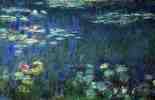These late C19th painters made advances in representation. They understood that for accurate representation of texture and light, colours on the canvas would have to be placed together in such a way that they appeared in harmony to the eye. They employed the technique of psychological manipulation of 'simultaneous contrast'.
Colours in the paintings were contrasted to those next to them, and whilst in close detail, appearing quite arbitary, harmonised when perceived by the eye which is at a distance from the painting itself. Thus their concern was to make the painting a self-contained unit and a harmonious whole. Pissarro is similar to Monet in this sense, who use complementary colours on a patchy surface to convey texture and light. It became characteristic of the impressionists to paint outdoors and for the brushstrokes to appear quite visibly in the final composition of the painting
Cezzane had a similar preoccupation with the whole and aimed to create a self coherent balance of colour on the surface. Cezanne tried to do this by eliminating lines, trying to make colour replace drawing. This was an almost impossible goal, and Cezanne was forced to use lines. Still the paintings have the remarkable affect of fullness, even though this created the problem that a single component of the painting could not be changed without changing the nature of the whole thing.
Anomalies that appear quite arbitrary when viewed close up were used to exhibit tension and feeling. In one painting of a woman�s back a blue purple colour is placed directly under the line of her breast that operates as a centrifugal point in the painting drawing the eye out to the canvas a whole. This allows the imagination to recreate the sensations of the subject.

